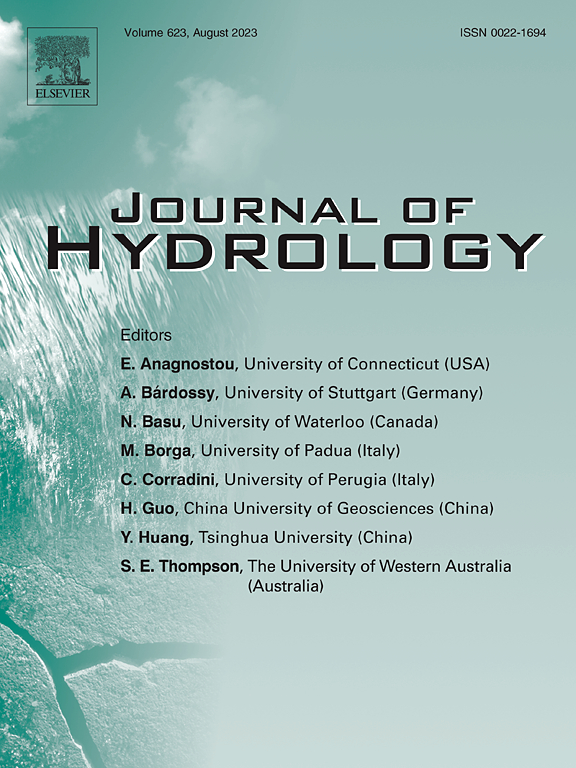Propagation patterns of different degree meteorological droughts across the Yangtze River Basin: a three-dimensional drought feature identification approach with Copula modeling
IF 5.9
1区 地球科学
Q1 ENGINEERING, CIVIL
引用次数: 0
Abstract
Extreme droughts have frequently affected the Yangtze River Basin (YRB), significantly impacting agriculture, ecosystems, and socio-economic conditions. However, it is challenging to quantify these drought degrees due to their spatial and temporal complexities, such as varying drought durations, severities, and affected areas. In this study, we proposed a framework to quantify different degrees of drought events combined with different drought characteristics. It consists of a three-dimensional drought feature identification method (longitude-latitude-time continuum identification) and the Copula function. Then, we analyzed the spatial and temporal evolution patterns of drought events of different degrees in the YRB during 1951–2022, and reviewed the occurrence and progression of three notable droughts (in 2006, 2019, and 2022) documented in the YRB. Temporally, the YRB experienced a higher frequency of severe droughts from 1951 to 1980, and an increase in extreme drought events primarily after 2000. Spatially, severe and extreme droughts were concentrated in the middle reaches, whereas moderate and light droughts were more common in the Jinsha River Basin. The east–west migration was the main propagation characteristics of drought patterns at different levels in the YRB. Notably, extreme droughts mostly resulted from the convergence and overlapping of several smaller extreme drought events, creating a significantly larger drought-affected area and higher severity.长江流域不同程度气象干旱的传播模式——基于Copula模型的三维干旱特征识别方法
极端干旱频繁地影响着长江流域,严重影响着农业、生态系统和社会经济状况。然而,由于其空间和时间的复杂性,如干旱持续时间、严重程度和受影响地区的变化,对这些干旱程度进行量化是具有挑战性的。在这项研究中,我们提出了一个框架来量化不同程度的干旱事件,并结合不同的干旱特征。它由三维干旱特征识别方法(经纬度时间连续体识别)和Copula函数组成。在此基础上,分析了1951—2022年长江三角洲不同程度干旱事件的时空演变特征,回顾了长江三角洲2006年、2019年和2022年3次显著干旱事件的发生和演变过程。从时间上看,1951 - 1980年长江三角洲严重干旱发生频率较高,极端干旱事件增加主要发生在2000年以后。从空间上看,重度和极端干旱集中在中游,中度和轻度干旱在金沙江流域较为常见。东西向迁移是长江流域不同水平干旱型的主要传播特征。值得注意的是,极端干旱主要是由几个较小的极端干旱事件的汇聚和重叠造成的,造成了更大的干旱影响面积和更高的严重程度。
本文章由计算机程序翻译,如有差异,请以英文原文为准。
求助全文
约1分钟内获得全文
求助全文
来源期刊

Journal of Hydrology
地学-地球科学综合
CiteScore
11.00
自引率
12.50%
发文量
1309
审稿时长
7.5 months
期刊介绍:
The Journal of Hydrology publishes original research papers and comprehensive reviews in all the subfields of the hydrological sciences including water based management and policy issues that impact on economics and society. These comprise, but are not limited to the physical, chemical, biogeochemical, stochastic and systems aspects of surface and groundwater hydrology, hydrometeorology and hydrogeology. Relevant topics incorporating the insights and methodologies of disciplines such as climatology, water resource systems, hydraulics, agrohydrology, geomorphology, soil science, instrumentation and remote sensing, civil and environmental engineering are included. Social science perspectives on hydrological problems such as resource and ecological economics, environmental sociology, psychology and behavioural science, management and policy analysis are also invited. Multi-and interdisciplinary analyses of hydrological problems are within scope. The science published in the Journal of Hydrology is relevant to catchment scales rather than exclusively to a local scale or site.
 求助内容:
求助内容: 应助结果提醒方式:
应助结果提醒方式:


